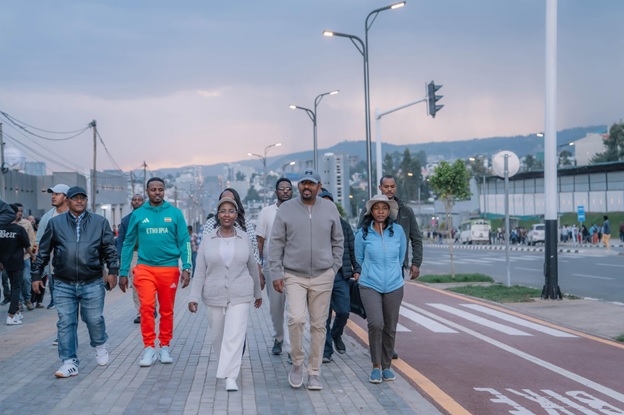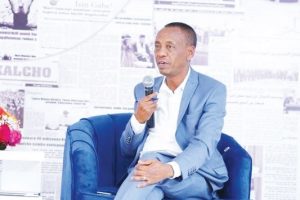
Recently, Ethiopia has begun to witness an urban transformation that goes beyond construction and asphalt—it is a reimagining of public space with the human being at its heart. Among the most compelling examples of this transformation is the newly inaugurated Anbesa Garage–Jukrose–Goro Square corridor in Addis Ababa. This development has turned what was once an overcrowded, congested, and accident-prone route into a well-organized and inclusive urban corridor that prioritizes the needs of residents, commuters, small business owners and visitors alike.
The corridor stretches from Anbesa Garage to Goro Square via Jukrose and is now a symbol of modern Ethiopian city planning. Once riddled with traffic jams and chaotic intersections, it now features well-leveled roads, designated lanes for various forms of transport, and safe public spaces. The project includes an 8-kilometer pedestrian walkway, a 4-kilometer cycle path, organized parking facilities, taxi and bus stations, public toilets, fountains, children’s playgrounds, and more than 870 standardized shops. These improvements are not just technical additions—they reflect a shift in thinking: from vehicle-focused to citizen-focused urban growth.
The corridor was officially opened in the presence of Prime Minister Abiy Ahmed (PhD) and Addis Ababa Mayor Adanech Abiebie. Their visit to the area highlighted the government’s dedication to designing spaces that serve people of all backgrounds and walks of life. Prime Minister Abiy praised the corridor for transforming a once problematic area into a model of accessibility and inclusiveness. His words resonated with the thousands of residents who have already begun to feel the benefits of this redevelopment—not only in terms of improved transportation but also in the enhanced quality of life it brings.
The Anbesa Garage–Jukrose–Goro Square project is not an isolated success story. It is part of a broader corridor development initiative that is steadily taking shape across Addis Ababa and, increasingly, across other Ethiopian cities. These corridors are not just roads—they are carefully designed networks that link people, services, commerce and leisure. They reflect a deep understanding that urban spaces should work for everyone, not just for drivers or large businesses.
This new corridor has done more than streamline traffic flow; it has created permanent jobs and opened opportunities for many residents. Small vendors, shopkeepers, taxi drivers and youth now have structured and dignified spaces to operate and grow. The standardized shops have enabled small businesses to flourish in cleaner, safer and more attractive environments. This structured commercial space provides stability for businesses that were previously operating informally and helps support families across the city. The project has also encouraged the use of non-motorized transport, reducing congestion and lowering pollution, which is a win for both the environment and public health.
Before its redevelopment, the route between Anbesa Garage and Goro Square was one of the most difficult to navigate in Addis. It was notorious for traffic congestion and frequent accidents. With the upgraded infrastructure, including proper bus and taxi bays, the area now experiences more organized movement of people and vehicles. The new layout has not only improved road safety but also made the city more livable and attractive for residents and visitors alike.
Mayor Adanech Abiebie emphasized that the redevelopment has generated thousands of jobs. This is because the corridor includes extensive commercial space, recreational facilities, and services that require ongoing maintenance and management. It’s a clear sign that urban development, when done right, doesn’t just change how a city looks—it changes how it lives and breathes. It creates opportunities, nurtures dignity, and fosters long-term community development.
Prime Minister Abiy’s message during the inauguration was especially powerful. He called upon other cities and sub-cities to adopt similar approaches—prioritizing people in every aspect of urban planning. His call reflects a nationwide vision to create cities that are not only modern but also inclusive and equitable. This vision aligns with the government’s broader goal of reconfiguring both urban and rural life to be more responsive to the needs of everyday people.
Urban renewal efforts are also underway in rural areas, where the development of corridors is beginning to make a real difference. In these areas, infrastructure investments are rejuvenating communities, improving access to markets and services, and raising the standard of living. Though rural corridors may look different from their urban counterparts, the underlying principle remains the same: development must be people-focused, accessible and dignified.
The idea of corridor development itself is not new, but the way it’s being applied in Ethiopia is both ambitious and uniquely inclusive. In many countries, corridor development tends to prioritize economic utility—focusing on speed and throughput for cars and trucks. Ethiopia’s approach, by contrast, is deeply social. It builds in spaces for walking, cycling, resting, playing and doing business. It blends transport, commerce, and recreation in one thoughtful design.
The corridor’s pedestrian walkway, for example, is more than just a sidewalk. It’s a place where families stroll in the evenings, where elderly citizens walk safely, and where schoolchildren commute with less fear of accidents. The cycle path encourages a culture of healthier, greener mobility. The plazas and playgrounds give people a reason to linger and connect, not just pass through. These public spaces also serve as informal gathering points for the community— bringing back a sense of social cohesion that often gets lost in rapidly growing cities.
Fountains, green spaces and modern lighting have transformed once dull and dangerous streets into beautiful and inviting spaces. These features are not superficial; they reflect a commitment to urban dignity. When a city invests in aesthetics, it sends a message: “You deserve beauty in your everyday life.” This message is powerful, especially in areas where residents have long been neglected or overlooked in development plans.
The corridor project also serves as a reminder that successful urban development requires cooperation between different levels of government. The collaboration between the Prime Minister’s Office, the Addis Ababa City Administration, and various sub-city administrations made the Anbesa–Jukrose– Goro Square project possible. This cooperation is key to ensuring that such projects are well-funded, well-executed and sustainable.
The potential for corridor development to expand into other cities is enormous. Cities such as Dire Dawa, Bahir Dar, Adama, Hawassa, Gondar and Mekelle all face urban challenges that could be addressed through similar projects. Each city has its own needs and context, but the core principles—safety, accessibility, commerce and inclusion—can be applied across the board. In doing so, Ethiopia can set a new standard for African urban development: one that doesn’t simply mimic global models, but innovates based on local needs and social values.
What we have learned from the Anbesa Garage–Jukrose–Goro Square corridor is that infrastructure is not just about roads and cement. It is about people—how they move, how they live, how they connect, and how they grow. When citizens feel safe, when children have places to play, when small businesses can thrive, and when neighborhoods are clean and beautiful, it transforms not only how a city looks but how it functions and how it is experienced.
Of course, no project is perfect. Maintenance remains a critical challenge. The public toilets, lights, playgrounds, and commercial spaces require regular care. City administrations must continue to allocate the necessary resources and personnel to keep these facilities in top condition. Community involvement in maintaining these shared spaces will also be crucial. Public pride must translate into public stewardship.
There is also the need to ensure that future corridor developments remain affordable and accessible. The goal must always be to serve the broadest cross-section of society, not just the affluent. This requires careful attention to pricing, placement, and design. Inclusive development is not only about who benefits from the space, but who can afford to stay and thrive in it.
Despite these challenges, the success of the Anbesa corridor stands as a compelling model for other projects to follow. It is proof that urban development, when done right, can uplift entire communities. It can transform unsafe streets into vibrant public spaces. It can generate jobs, support businesses, and improve health and safety. It can bring people together in shared spaces and experiences, making cities more than just places to live—but places to belong.
Addis Ababa, like many cities across the developing world, is growing rapidly. With growth comes pressure: on infrastructure, on services, on public space. Corridor development offers a smart, scalable solution to some of these pressures. By continuing to invest in people-first infrastructure, Ethiopia is positioning its cities not only as places of residence and commerce but also as beacons of modern African urbanism.
As we look ahead, let this project inspire more innovation, more collaboration, and more focus on inclusive growth. Let it remind us that every road and walkway built is a reflection of our values—how we see our people and how we imagine our future. Ethiopia’s corridors are more than paths across space; they are pathways toward equity, dignity and shared prosperity.
BY WAKUMAN KUDAMA
THE ETHIOPIAN HERALD SUNDAY EDITION 15 JUNE 2025




